With the advent of modern analytical techniques, it has become a necessity to be able to perform a complete analysis from a single dissolution. In order to improve solution manufacturing, XRF Scientific has designed several models of fusion machines. These instruments offer many benefits, including increasing productivity and repeatability and productivity without the risks for the operators to manipulate dangerous reagent.
The processes are simpler, quicker and cleaner. Distinguished below are two types of fusions for ICP that require specific conditions and environment. Based on more than 25 years of experience, XRF Scientific has developed the most suitable fusion machines whilst making significant advances to meet exactly these specific fusion requirements.
XRFUSE 1, 2 and 6 ICP
Rugged electric fusion machine designed for the preparation of 1 to 6 acid solutions for analysis by AA or ICP. When functioning in ICP mode, the fused samples are automatically poured into the Teflon beakers containing the dilute acid solution. With the help of magnetic stirring, the beakers remain in position up to complete dissolution.
The machine is equipped with an exhaust fan, which removes the acid vapor created when the hot liquid is poured into the beaker. Dependent upon the model, the ICP modules can accept one, two or six beakers of 100 ml. Each position is fitted with a separate magnetic stirring.
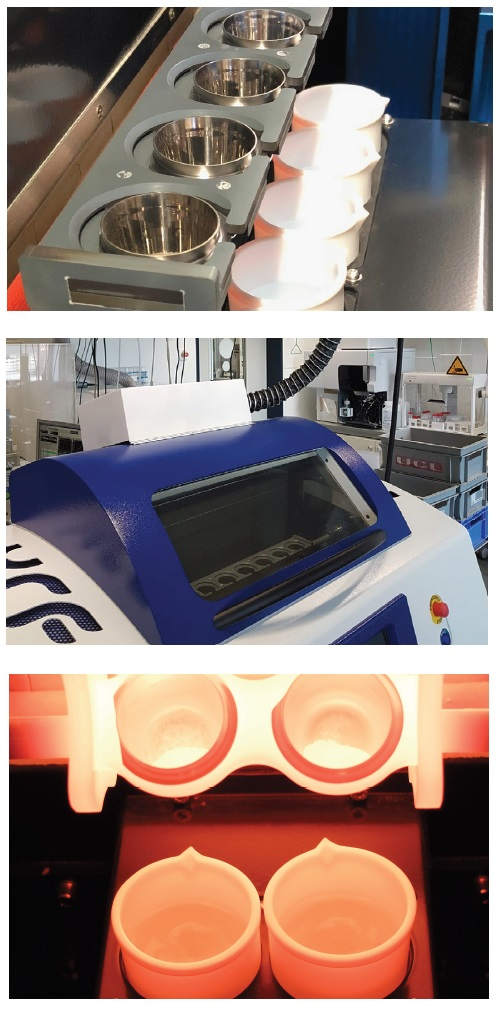
Key Features
- Fully Automatic: Premelting, melting, shaking, pouring and magnetic stirring
- Maximum Temperature 1250 °C (1200 °C continuous)
- Real-time temperature reading
- Homogenization by rocking, variable angle, and speed
- Touch screen user interface, password protected engineer levels
- Up to 12 user-defined recipes with naming flexibility
- Crucible holder: Hi-purity ceramic, no contamination
- Adjustable pouring angle
- 2 stages magnetic stirring
- Cool-touch glass viewing window; Lid safety-interlocked during fusion and standby mode
- Safe enclosed, cold to cold operation
- Emergency stop button
- Ethernet and USB communication link
Table 1.
| Item Code |
Description |
| xrFuse 1 |
Produces 1 sample simultaneously ICP |
| xrFuse 2 |
ICP Produces 2 samples simultaneously ICP |
| xrFuse 6 |
ICP Produces 6 samples simultaneously ICP |
The XRFUSE ICP for Borate Fusion
The borate fusion consists of mixing a powder sample with a fusion flux inside a platinum-5% gold crucible, heating to about 1000 – 1150 °C with agitation until complete reaction and dissolution to form a homogeneous molten glass. The molten glass is then cast into the beaker until the vitreous mass is thoroughly dissolved.
This method is currently the most widespread for the analysis of geological and elaborate materials, enabling the determination of major elements and a certain number of elements in traces. One major benefit of the xrFuse is that they are prepared for serial dissolutions, the fusion and digestion are fully automated inside the machine.
Here below the list of the most used fluxes and examples of applications for them.
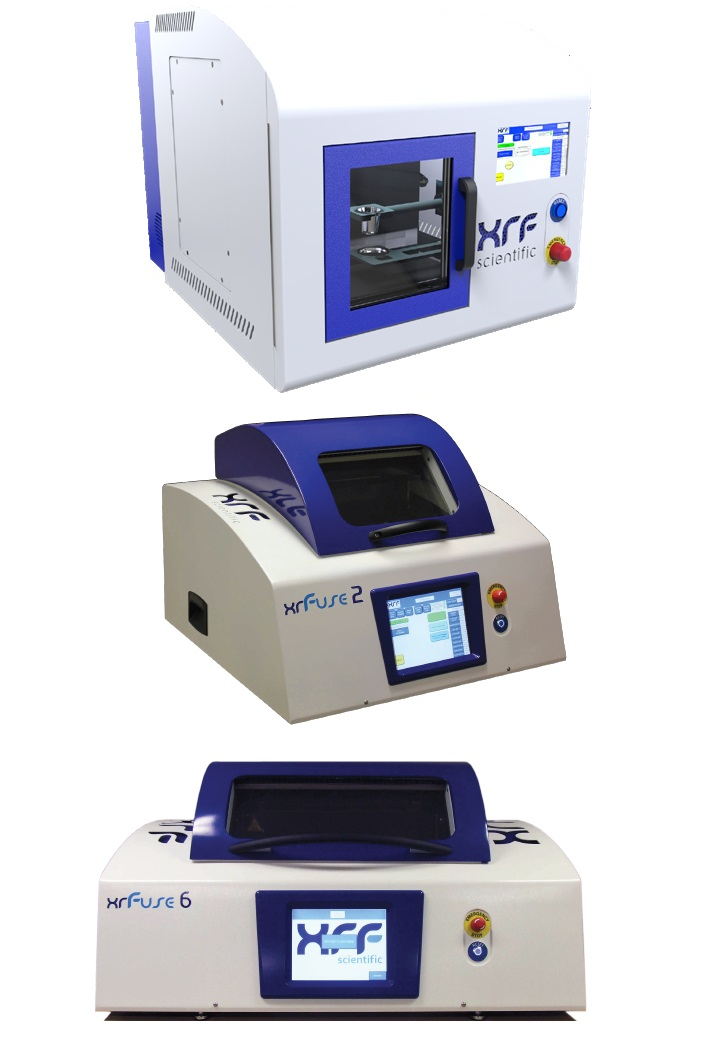
Typical Sample Preparation
- Platinum-5% gold crucible
- Flux: Lithium Metaborate + 0.5% LiBr
- 5 - 10 minutes of heating at 1000 °C
- Dilution: 1:4 (0.4 g sample for 1.6 g flux)
- 4 - 8 minutes dissolution in a beaker containing about 90 ml of 5% HNO3 w/v
Enough releasing agent is used to be sure the transfer is complete. Typically, 0.5% Lithium Bromide.
Table 2.
| Flux Name |
Melting P. (°C) |
Dilution |
Applications |
| Lithium Metaborate |
845° |
1:4 |
Fusion of Silicates, Rocks |
| Lithium Tetraborate |
920° |
1:4 |
Fusion of Dolomites, Carbonates, Aluminates |
| Mix of 66% Lithium Tetraborate and 34% Lithium Metaborate |
875° |
1:4 |
Fusion of Refractories, Chromites, Fusion of Aluminosilicates, Zirconium silicate, Limestone, Lime |
The PHOENIX GO ICP for Peroxide, Carbonate or Hydroxide Fusion
The peroxide fusion consists of mixing a powder sample with an alkali fusion flux inside a zirconium or nickel crucible, heating to approximately 600 – 800 °C with agitation until complete reaction and dissolution of the sample in the flux.
Then the hot mixture is cooled in situ to produce a vitreous mass often colored and easily soluble in dilute acids. In this type of fusion, reactions are made at extremely different temperatures and they can sometimes be very energetic with a possible risk of spattering.
The Phoenix GO ICP is the perfect tool as it can be programmed with an infinite amount of heating steps to gently bring the mix to temperature, all being done behind a safety door for the protection of the operator. The table below shows the most used fluxes and examples of applications for them.
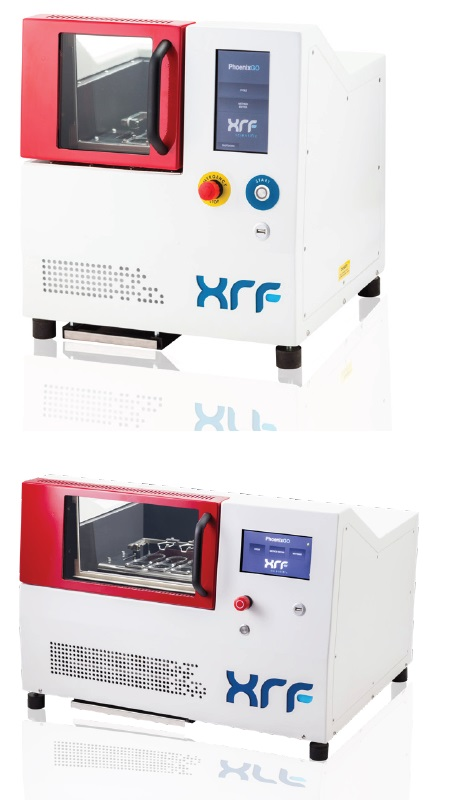
Table 3.
| Flux Name |
Melting P. (°C) |
Dilution |
Applications |
| NaOH |
318° |
1:5 |
Determination of Mo, W, F, Cl and B. Fusion of Silicates, Aluminates, Titanium oxide, Bauxites, Phosphates, Fluorides, Carbides, Silicon, Sulfides |
| KOH |
360° |
1:5 |
A fusion of Tantalum and Niobium ores |
| Na2O2 |
460° |
1:15 |
Determination of Pt, Rh, and Pd.Fusion of Refractories, Chromites, Resistant alloys… Sodium peroxide is very reactive |
| Na2O2 - Na2CO3 |
- |
1:15 |
By adding 1 g of sodium carbonate to 5 or 8 g of sodium peroxide, violent reactions are less likely to occur |
| Na2CO3 |
853° |
1:4 |
Determination of F, Cl, and B.Fusion of minerals, Aluminosilicates, Barite |
| K2CO3 |
903° |
1:4 |
Determination of F, Cl, and B.Fusion of Aluminosilicates, Zirconium silicate |
| Na2CO3 - K2CO3 |
712° |
1:4 |
Determination of F, Cl, and B.Fusion of Aluminosilicates, Zirconium silicate |
Their reactivities can be classified as follows: 1. Peroxide, 2. Hydroxide, 3. Carbonate
Typical Sample Preparation
- Zirconium crucible (nickel crucible is limited at 600 °C)
- Flux: NaOH
- Dilution: 1:5 (1 g sample for 5 g flux)
- 5 - 10 minutes of heating from 300 °C up at 600 °C
- Heating 1, at 300 °C typically used to pre-heat the sample, no agitation
- Heating 2, at 400 °C typically used to initiate the reaction, little agitation
- Heating 3, at 600 °C typically used to complete the reaction,
- 4 minutes of cooling
- Cooling 1, soft cooling
- Cooling 2, forced cooling
- Dissolution in a 5% HNO3 w/v
These new gas fusion machines are designed to do multiple and repeatable fusions with hydroxide, peroxide and carbonate. These new Phoenix machines only use gas, without the need for oxygen and compressed air. They are developed for high uptime applications and made to endure repetitive exposure to aggressive environments.
With 8 fusion stations, the Phoenix GO 8000 ICP is specially made for high volume. The user interface is designed in such a way that it can match the needs for the most versatile application with an infinite amount of configurable steps.
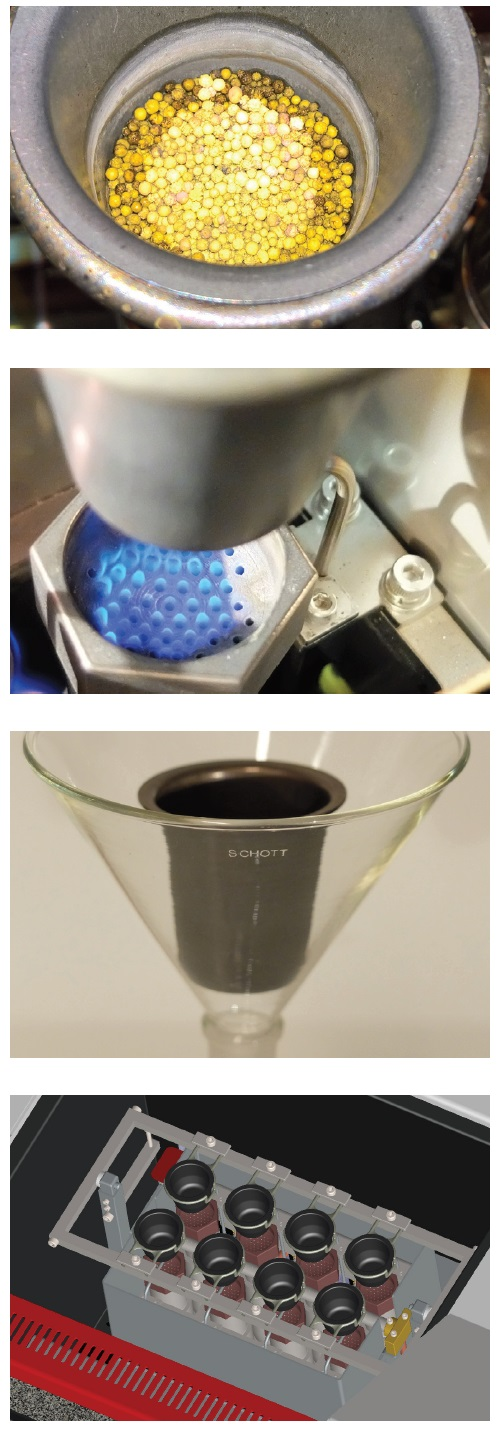
Key Features
- Fully Automatic: preheating, heating, swirling and cooling
- Gas only fan-forced burner – new technology
- Temperature: 300 - 1000 °C
- Temperature measurement: Thermocouple near a flame (indicative)
- 2 or 8 fusion stations
- Multiple heating steps programmable
- Up to 100 user-defined recipes with naming flexibility
- Homogenization by swirling
- Crucible cooled above the burner
- Emergency stop button; Automatic gas cut-off safety system, active burner monitoring, cold-to-cold operation, safety rated lid switch
- Touch screen user interface
- USB communication link
Table 4.
| Item Code |
Description |
| PHOENIX GO 2000 ICP |
Produces 2 samples simultaneously – fusion for ICP |
| PHOENIX GO 8000 ICP |
Produces 8 samples simultaneously – fusion for ICP |
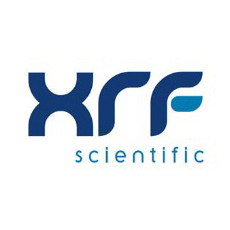
This information has been sourced, reviewed and adapted from materials provided by XRF Scientific.
For more information on this source, please visit XRF Scientific.